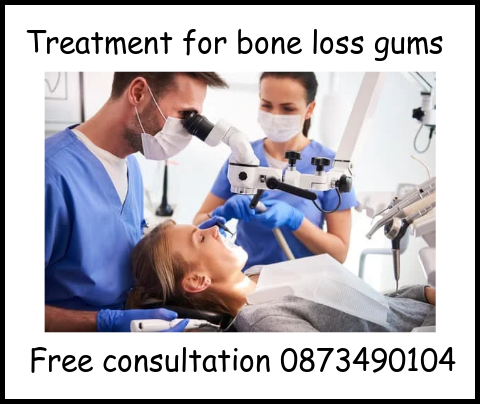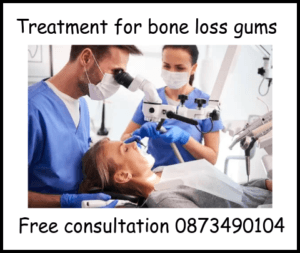If you are considering dental treatments like implants or crowns you may need treatment for bone loss gums.
In this short post we will look at what causes bone loss in the gums, what are the best treatments for a loss of bone in the gums, where is the best and cheapest place to go for treatment for bone loss gums.
Bone loss in the gums, also known as periodontitis, is a serious condition that requires proper treatment for bone loss gums to prevent further complications.
Here are a few treatment options that can help address bone loss gums:

1. Scaling and root planing:
This is a non-surgical procedure commonly referred to as deep cleaning.
It involves removing plaque and tartar from the surface of the teeth and smoothing out the roots to discourage plaque buildup.
Scaling and root planing help remove infection-causing bacteria and promote gum tissue healing, which can help prevent further bone loss.
2. Pocket reduction surgery:
In cases where the gum pockets are deep and cannot be adequately cleaned through scaling and root planing, pocket reduction surgery may be necessary.
This surgical procedure aims to reduce the pocket depth by eliminating bacteria and irregularities on the root surfaces.
The gums are then repositioned to facilitate easier cleaning and prevent further bone loss.
3. Bone grafts:
Bone loss in gums often results in a loss of the supporting bone structure. In such cases, bone grafts may be performed to regenerate bone growth, bone grafts are one if the most popular treatments for bone loss gums.
This involves using either synthetic bone material or your own bone taken from another area of the body to replace the lost bone.
Over time, the graft material integrates with the existing bone, helping to restore your gum’s health and stability.
4. Guided tissue regeneration:
This procedure is typically performed in conjunction with bone grafting. It involves using a thin barrier membrane placed between the gum tissue and the bone.
This membrane helps to prevent the growth of gum tissue into the bony defects, allowing the regrowth of bone instead.
5. Antibiotic treatment:
In certain cases, antibiotics may be prescribed to control the bacterial infection and reduce inflammation.
They can be administered both topically and orally, depending on the severity of the gum disease.
Treatment for bone loss gums is crucial for dental treatments such as dental implants or crowns.
The condition of the underlying bone plays a significant role in the success and longevity of these dental procedures.
Bone loss in the gums can occur due to various factors, including periodontal disease, tooth loss, or trauma.
When the bone is compromised, it lacks the necessary support to hold dental implants securely in place.
Additionally, sufficient bone structure is essential for the proper placement and stability of dental crowns.

Dental implants or crowns with bone loss gums
In cases where bone loss has occurred, dental professionals may recommend treatment for bone loss gums such as a bone grafting procedures.
These procedures involve adding bone or bone-like materials to the affected area to stimulate new bone growth.
This helps to restore the strength and density of the bone, providing a stable foundation for dental implants or crowns.
Without addressing bone loss, dental treatments like implants or crowns may not be successful or could lead to complications.
Implants may fail to integrate with the surrounding bone or may be at a higher risk of loosening over time.
Similarly, crowns placed on weak or inadequate bone may not provide adequate support and may result in discomfort or early failure.
Prioritize treatment of bone loss gums
Therefore, it is essential to prioritize the treatment of bone loss gums before undergoing dental procedures like implants or crowns.
This will increase the chances of successful outcomes and improve the overall oral health and function of the patient.
Treatment for Bone Loss Gums in Hungary versus Ireland
Bone loss in gums, also known as periodontal disease, is a prevalent dental condition that can lead to tooth loss if left untreated.
Seeking appropriate treatment is crucial for restoring oral health. When considering treatment options, cost often plays a significant role in decision-making.
This analysis aims to compare the cost of treatment for bone loss gums in Hungary and Ireland, allowing individuals to make informed choices regarding their dental care.

Cost Factors:
Several factors contribute to the overall cost of treatment for bone loss gums, including:
1. Severity of the condition:
The more severe the bone loss, the more extensive and complicated the treatment required, resulting in higher costs.
2. Treatment method:
Various treatment options, such as scaling and root planing, gum grafting, dental implants, or bone regeneration, have different associated costs.
3. Dentist’s expertise:
Highly experienced and specialized dentists may charge higher fees for their services.
4. Location:
Different countries have varying costs of living and healthcare expenses, leading to differences in dental treatment costs.
Cost Comparison Bone loss gums
To assess the cost of treatment for bone loss gums, we will compare Hungary and Ireland based on the following treatments commonly used:
1. Scaling and Root Planing:
This non-surgical procedure involves removing plaque and tartar from the tooth’s surface, eliminating bacteria that cause gum disease.
Hungary: Prices range from €25 to €70 per tooth.
Ireland: Prices range from €40 to €120 per tooth.
2. Gum Grafting:
This surgical procedure involves transplanting gum tissue to cover exposed tooth roots and prevent further gum recession.
Hungary: Prices range from €200 to €600 per tooth.
Ireland: Prices range from €800 to €1,500 per tooth.
3. Dental Implants with bone loss
These are artificial tooth roots surgically placed in the jawbone to support replacement teeth.
Hungary: Prices range from €600 to €800 per implant.
Ireland: Prices range from €1,500 to €3,000 per implant.Conclusion:
When comparing treatment costs for bone loss gums in Hungary and Ireland, it is evident that Hungary generally offers more affordable options.
However, it is crucial to note that other factors, such as the dentist’s expertise and the severity of the condition, should also be considered when making a decision.
It is recommended that individuals assess their specific needs, budget, and consult with dental professionals in both countries to determine the most appropriate and cost-effective treatment plan.
Contact us at Hungarian Dental Implant Centre Wexford for more information on the best and cheapest place to go for treatments on bone loss gums.
Prioritizing oral health and seeking timely intervention can prevent further deterioration of bone loss gums and maintain a healthy smile.

Consulting with a qualified dental professional
Consulting with a qualified dental professional is advisable to determine the appropriate treatment options based on individual circumstances.
It’s important to note that the success of these treatments depends on the severity of bone loss in the gums and prompt intervention.
Therefore, it is crucial to seek professional dental care as soon as possible if you suspect you may be experiencing or looking for more information on treatment for bone loss gums.
A qualified dentist or periodontist can evaluate your condition and develop a personalized treatment plan to address your specific needs.
References
https://www.ncbi.nlm.nih.gov/pmc/articles/PMC7664094/
https://www.ncbi.nlm.nih.gov/pmc/articles/PMC10044990/

